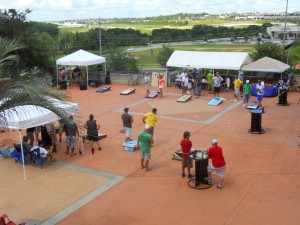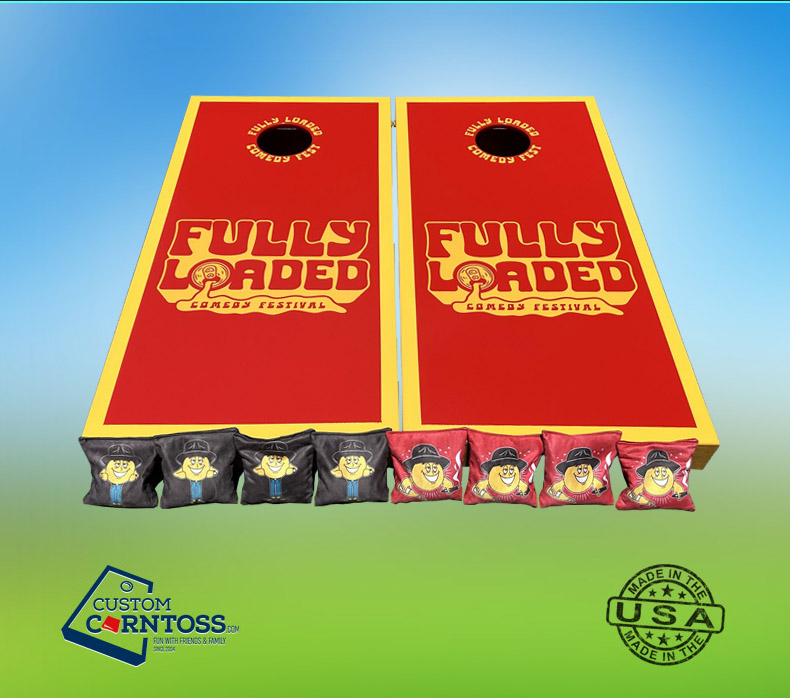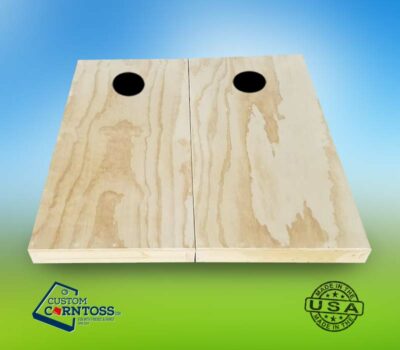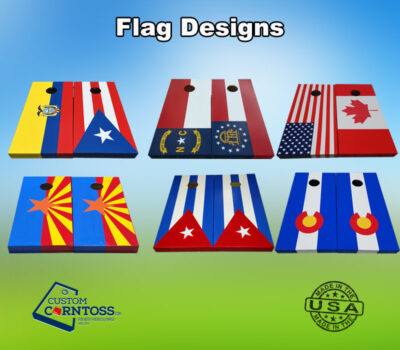Cornhole Guide

A Complete Guide to the Official Cornhole Game
Cornhole is an outdoor game that is popular throughout the US. This family-friendly pastime actually has a long history, even though it has only recently become a mainstream form of entertainment.
Also known as corn toss, bean bag toss, soft horseshoes, tailgate toss, baggo and bags, cornhole is a fairly simple game. The rules and game play are easy to understand, making it a great game for all ages and abilities.
With a minimal amount of equipment, the official cornhole game can be played just about anywhere. Because of its versatility, cornhole has become a necessity for popular activities like tailgating and backyard BBQs.
Cornhole is an enjoyable form of entertainment. However, it’s also a competition. Therefore, there are official guidelines intended to standardize cornhole game play. Below is an outline of the regulations regarding the equipment, court, game play, scoring, and more.

Cornhole Bags and Boards
Cornhole game sets consist of two pieces of equipment: the cornhole boards and bags.
To play, participants will need access to two cornhole boards and four cornhole bags per player. In order to easily distinguish points earned, each player should have a different colored set of bags
Regulation Cornhole Board Dimensions and Requirements
 Official cornhole boards must be constructed from wood.
Official cornhole boards must be constructed from wood.- The regulation size cornhole board dimensions are as follows:
- The cornhole board size will measure 48 inches by 24 inches.
- The standard cornhole size will be six inches in diameter.
- The cornhole will be centered 9 inches from the top of the board and 12 inches from both sides.
- From top to bottom, the front edge of the cornhole board will measure 2.5 - 4 inches.
- The back edge of the cornhole board will be 12 inches from the ground.
- The surface of the cornhole board must be free of blemishes that could possibly impede play.
Regulation Cornhole Bag Requirements
- The size of official cornhole bags will measure 6 inches by 6 inches.
- The final weight of the cornhole bags will be approximately 15 ounces.
- Two pieces of duck canvas will be sewed together with a quarter inch double stitched seam.
- Each bag will be filled with 2 cups dried corn kernels.
Regulation Cornhole Court Dimensions and Layout
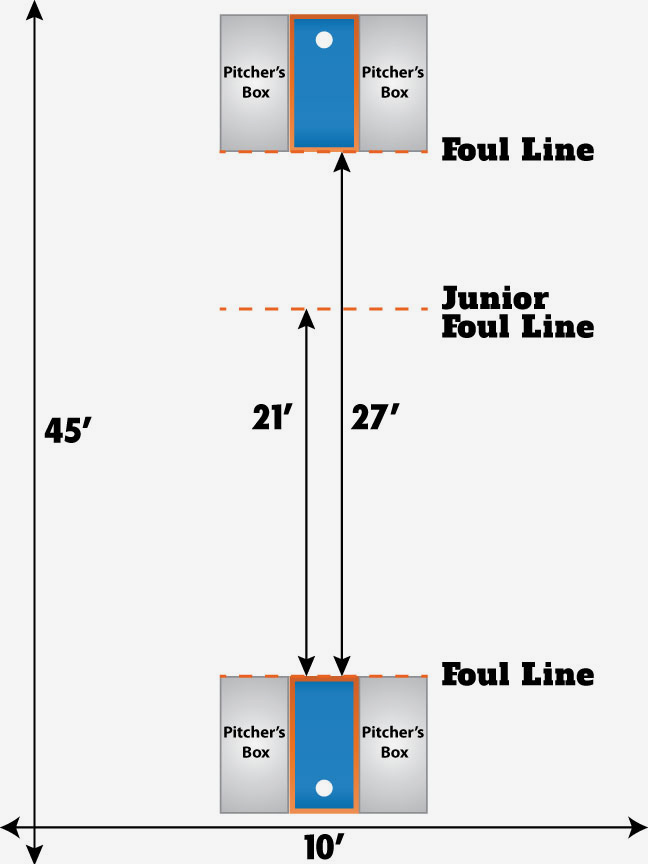 The game of cornhole is played on a court. While this court can be set up just about anywhere, there are certain rules that apply to its overall design and size.
The game of cornhole is played on a court. While this court can be set up just about anywhere, there are certain rules that apply to its overall design and size.
- A large, rectangular area is needed--at least 10 feet wide by 45 feet long.
- If multiple cornhole courts are laid out side-by-side, there must be 10 to 12 feet distance between each cornhole court.
- If the cornhole court is set up inside, there must be 12 feet of vertical clearance.
- The cornhole court must be level.
- Before play begins, all players must evaluate the condition of the cornhole court. Any obstacles should be removed prior to play. No changes can be made the court once play begins.
- To reduce the effects of sun, avoid courts that are aligned east to west.
- A pitcher’s box can be found parallel to each cornhole board. It extends three feet from either side of the board. All pitches must be made from this area—the players must remain in the same box for the entire inning.
- The foul line extends parallel from the front edge of each cornhole board. The official regulation distance between the front edge of one cornhole board to another is 27 feet.
- The foul line for junior play will be a distance of 21 feet from the front edge of one cornhole to the front edge of the opposite board.
- The foul line for adult play will be a distance of 27 feet from the front edge of one cornhole to the front edge of the opposite board.
Regulation Cornhole Rules and Gameplay
 Before play begins, players must agree on either a singles or doubles match.
Before play begins, players must agree on either a singles or doubles match.- In a singles match, one competitor competes against another. Both competitors toss from the same board. After each inning, the players switch boards and aim at the other target.
- In double play, two teammates compete against two other competitors. One competitor from each team tosses from the same platform; the two remaining competitors toss from the other board. At the conclusion of each inning, the players switch boards and aim at the other target.
- A cornhole game is divided into innings.
- In singles play, both competitors pitch four bags each from the same board, alternating between players. The inning is complete when all eight bags have been tossed.
- In doubles play, two opponents pitch four bags each from the same board, alternating between players. When two competitors have finished, the other two players toss their bags in the same manner from the other board. The inning is complete when all four participants have tossed.
- Each board has two pitcher’s boxes. A player may toss from either side of the board, but must remain in the same pitcher’s box for the duration of an inning. He or she may switch to the other pitcher’s box in the next inning if the player so chooses.
- Once the player steps into the pitcher’s box, he or she has 20 seconds to toss the bag.
- A player must toss with the same hand for the entire match (or tournament).
- Pitching order:
- The player who scored the most points in the preceding inning tosses first in the following inning.
- If no one scored in the preceding inning, the competitor who pitched second will be the first player to toss in the following inning.
- In doubles play, the player who is not tossing must respect the space of the pitching opponent. He or she must stand at least 2 feet behind the competitor.
Fouls
The following actions are considered fouls. If one of these things should happen, the tossed bag must be removed from the court before play can resume:
- Crossing the foul line while pitching
- Stepping outside the pitcher’s box after entering it with the intention of tossing
- Failing to toss the cornhole bag within 20 seconds of entering the pitcher’s box
- Switching pitcher’s boxes during the same inning
- Dropping the bag after the pitch’s forward swing has begun
Scoring
Earning Points:
- Three Points: A hole-in scores three points. This is a bag that passes through the hole. It can be tossed there, come to rest there after sliding across the board, or knocked in by another bag.
- One Point: Any bag that lands on the board (but doesn’t pass through the hole) earns one point. However, the bag cannot touch the ground (or any other part of the court) before resting on the board.
- Zero Points: A bag that comes to rest anywhere outside the board and does not pass through the hole earns zero points. Any cornhole bag that hits the ground before landing on the board is considered a foul and must be taken off the board before play resumes.
- The first team (or competitor in singles play) to reach or exceed 21 points wins.
- It is possible for a team to win via a skunk. If one team scores 7 or more points before the opponent score any points, the team that has scored wins.
- A match cannot terminate mid-inning. Even if a team reaches 21 points, play must continue until the inning concludes.
- If, at the end of the inning, teams are tied at or beyond 21 points, play will continue until there is a winner.
- Using cancellation scoring:
- Hole-ins cancel each other out. If Player A score two hole-ins and Player B scores one, Player A earns only three points and Player B earns zero. The hole-ins cancel each other out and only the un-cancelled hole-ins earn points.
- Bags in-the-court cancel each other out. If Player A lands three bags in-the-court and Player B lands two bags in-the-court, Player A earns one point and Player B earns zero. The in-the-court bags cancel each other out and only the un-cancelled bags earn points.
Cornhole Culture and Popularity
 Since its inception, cornhole has become a staple in American entertainment. The popularity of cornhole is derived from a variety of factors:
Since its inception, cornhole has become a staple in American entertainment. The popularity of cornhole is derived from a variety of factors:
- The game can be played anywhere. You don’t need a court like basketball, a field like football or even sandpits like horseshoes. Cornhole boards can be placed on just about any flat surface.
- People of all ages and abilities can play cornhole. The bags are light and easy to toss. The rules are fairly straightforward and easy to understand.
- The equipment is simple to store and transport. The boards and bags take up very little space. Plus, boards usually come with handles, making them easy to haul from place to place.
Cornhole is most famously known for its contribution to tailgating parties. For American sports enthusiasts, the pre-game party is nearly as important as the actual sporting event. Fortunately, cornhole can help with that.
Because of its close associate with sports, it is common for cornhole boards and bags to be customized with sport team logos or mascots. Additionally, cornhole games often turn into highly charged competitive activities.
But stadium parking lots aren't the only place cornhole boards are erected. Cornhole is usually a staple for backyard parties, BBQs, family reunions, or just about any other outdoor activity.
Often times, cornhole is taken inside too. Physical education teachers know cornhole is the ideal indoor activity when the weather is too inclement for outdoor learning.
In bars and pubs all across the country, cornhole has replaced traditional games like darts. Individual cornhole matches and tournaments take place in conjunction with drinking and socializing. Some bar patrons even turn the cornhole match into a drinking game.
While cornhole is often thought of as a form of entertainment, it also has practical uses. Many companies host cornhole tournaments as clever marketing events. Likewise, many charities and non-profit organizations host cornhole tournaments to raise money.
The Legends and Origins of Cornhole
The origins of cornhole are numerous and are indeed varied by region and legend. There are two main theories about how the game itself got started.
The Legend of Cornhole: A German Solves a Problem
The first legend has it that a German farmer invented it sometime around the year 1325. The story goes that he was walking home from tilling his fields one day when he came across boys trying to throw large, heavy rocks into a hole that was in the ground. The farmer remarked that they could get hurt playing this game, but the boys wouldn't stop what they were doing.
So the farmer went home that night and filled cloth swatches with dried corn kernels before stitching them together to make sacks. Of course, he couldn't find the boys the next day, but he and his family were able to replicate the game on their own land with the corn kernel sacks instead of cumbersome rocks.
From there it's said that German immigrants brought the game over to the colonies with them, and the game had little success among farmers and pioneers. Cornhole as a game was not rediscovered until about the early 1900's in the state of Kentucky.
The Legend of Cornhole: An American Pastime

The second major legend in the history of cornhole is one with a more modern flair. This account has it that a Midwest farmer in the 1900's invented the game as a way to pass the time between farm work.
Others claim a very similar pastime was already being enjoyed by Native Americans in the Midwest (mostly the Blackhawk tribe). Pigs’ bladders were filled with dried beans and tossed in a similar fashion.
These stories then go on to recount that the first actually documented games occurred in the west side of Cincinnati among bar patrons. After these games had garnered enough of a local following, the game became a popular past time for tailgating parties and group events. Of course it didn't take long for people visiting Cincinnati to see the game and bring it back to their own states. As a result, the game spread and has stayed as a tailgating mainstay to the current date.
Although cornhole has remained fairly consistent in both its required equipment and its rules, there have been a few modifications over time. Since the original sacks were made of cloth and filled with corn kernels, they didn't last long-- especially if they got wet.
With the more modern incarnation of the game, cloth has been replaced by a more durable material, and the kernels have been replaced with plastic pellets. Now, the bean bags last longer and can be used over and over again. Durability of the equipment has been an important part of the game's longevity.




